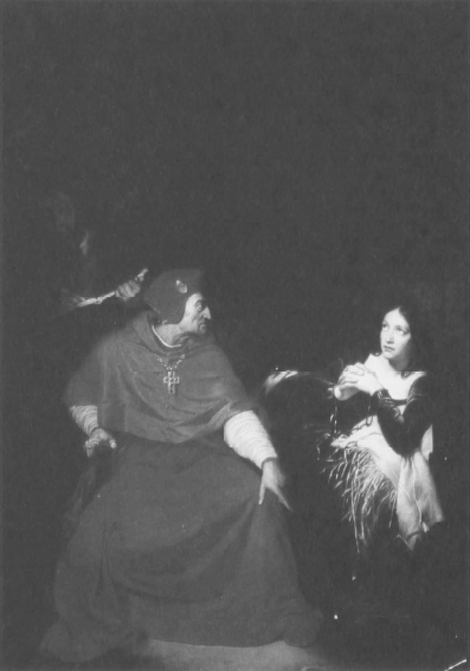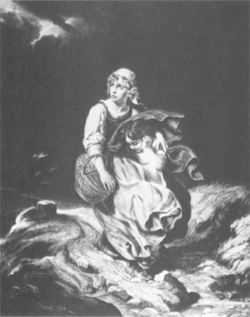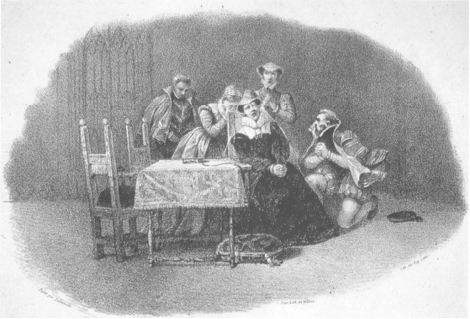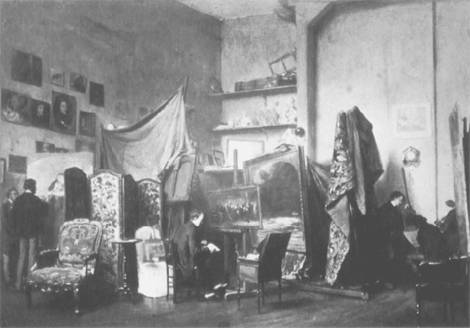Van Gogh Museum Journal 2000
(2000)– [tijdschrift] Van Gogh Museum Journal–
[pagina 74]
| |
 fig. 1
Paul Delaroche, Joan of Arc in prison, 1824, Rouen, Musée des Beaux-Arts | |
[pagina 75]
| |
Goupil, Delaroche and the print trade
| |
[pagina 76]
| |
 fig. 2
Samuel William Reynolds after Paul Delaroche, Les enfants surpris par l'orage, from Alfred Whitman, 19th-century mezzotinters: S.W. Reynolds, London 1903 during the 1820s,Ga naar voetnoot7 seems to have taken a particular interest in Paul Delaroche, at that time a promising young painter who had only recently made his Salon debut and was to make his fortune thanks to the enormous popularity of his work - mainly on subjects from English history - during the Restoration and July Monarchy. Arrowsmith owned his Enfants surpris par l'orage (present location unknown), from which he commissioned an engraving by Reynolds (fig. 2); he also asked Reynolds to engrave Filippo Lippi (Dijon, Musée Magnin) - a picture the dealer must have admired but was presumably unable to buy.Ga naar voetnoot8 Small-scale pictures on historical subjects were the stock in trade of such men during the Restoration. Delacroix painted a number of these scenes and on at least one occasion received a commission from Arrowsmith.Ga naar voetnoot9 S.W. Reynolds wrote to his daughter-in-law from Paris at this time: ‘I have been painting little interiors of churches which are all the rage here.’Ga naar voetnoot10 This vogue for subjects from medieval history, associated with a marked taste for local colour and Gothic architecture (as Reynolds's letter suggests), can surely be related to two contemporary phenomena with which Arrowsmith had familial connections. The first of these was the diorama, patented by yet another artist specialising in church interiors, John Arrowsmith's brother-in-law, Louis Mandé Daguerre.Ga naar voetnoot11 The second was the publication in 1822 of Charles Nodier and Baron Taylor's Voyages pittoresques. In an early volume, Nodier wrote: ‘Begun in the interest only of poetic, picturesque memories, these voyages became, gradually, the picture of the doings of the Middle Ages. Such is the connexion between the history of monuments and that of men, that we were unable to close our ears to the solemn voice of the past, recounting memorable events in the midst of ruins.’Ga naar voetnoot12 Arrowsmith's brother Charles was also a painter of the kind of church interior mentioned by S.W. Reynolds, and Daguerre made several prints for the Voyages pittoresques, as did Géricault and Bonington. Delaroche did not, as far as I know, contribute to the publication, although he did collaborate with Bonington on a smaller but comparable enterprise, Amedée Pichot's Vues pittoresques de l'Ecosse (fig. 3).Ga naar voetnoot13 Arrowsmith's tastes and activities thus placed him at the very heart of artistic fashion in Paris during the middle years of the Restoration. His capital was presumably insufficient to allow him to keep it tied up in stock for any length of time; he held a final sale of pictures in Paris in | |
[pagina 77]
| |
 fig. 3
Eugène Lami after Paul Delaroche, Mary Stuart at the castle of Loch Leven, Oxford, private collection | |
[pagina 78]
| |
1826, though he continued to publish prints for some time.Ga naar voetnoot14 Many years after his death sometime around mid-century, his daughter wrote of him: ‘My father painted a little, but he was above all an art-lover and connoisseur. He found the firm of Goupil and several others. He was intelligent and full of ideas, but unfortunately very extravagant. He had learned to behave like an aristocrat and that is how he lived.’Ga naar voetnoot15 This curious statement - that John Arrowsmith was the founder of the firm Goupil & Cie. - though never, as far as I know, mentioned elsewhere, seems to be borne out by some circumstantial evidence. When the young Adolphe Goupil registered as a print dealer in 1829Ga naar voetnoot16 it was in partnership with a German named Henry Rittner, some four years older than himself and who had been publishing prints since 1827. His name appears on a number of prints together with that of John Arrowsmith. These include those after Delaroche's Filippo Lippi and Joan of Arc, Bonington's Meditation,Ga naar voetnoot17 and a set of aquatints after drawings by Newton Fielding that Rittner and Arrowsmith published in 1828. Rittner was to meet his future partner Goupil through a mutual friend - a marine artist named Charles Mozin,Ga naar voetnoot18 some of whose work passed through Arrowsmith's hands. Several years after Goupil and Rittner went into partnership, Rittner married Goupil's sister-in-law.Ga naar voetnoot19 One of their early joint publications was a set of etchings by Paul Huet. The third etching in this series, Maison du garde, sur le bord d'une forêtGa naar voetnoot20 is based on the picture of similar title dated 1827 (private collection).Ga naar voetnoot21 The composition resembles that of The hay wain, which Arrowsmith had so successfully introduced to the French public the previous year. There is, therefore, some reason to think that Arrowsmith was influential in directing the new firm towards the publication of prints after works by the young generation of romantic artists, most of whom he is said to have known intimately. He can thus be credited with having laid the foundations for Goupil's future fame and prosperity - the reproduction of popular Salon favourites - that ‘imaginary museum’ which was later to prove so stimulating to Vincent van Gogh, when, as a young man, he was an employee of the firm. By the early years of the July Monarchy, Arrowsmith's tastes were less in evidence at Goupil's. The firm had altered slightly in character, having moved from publishing reproductions of paintings by celebrated artists to the lighter material of popular lithography. However, Goupil would soon again turn to Delaroche, this time as a painter of singers and actresses, at the time when he had just completed his portrait of Mademoiselle Sontag (formerly Staatliche Kunstsammlung Dresden, Gemäldegalerie). This was followed by the likeness of Mademoiselle Alaunde Dorval, which was lithographed by Gigoux.Ga naar voetnoot22 Subsequently, prints after Delaroche appear with some frequency until 1839, when the firm brought out only three prints in all and it seemed they might be going out of business. But in 1840 there was a renewal of activity, and a significant change in the quality of the engravings published. A number of Salon works appeared, executed in expensive copperplate by the most famous printmakers of the period, Calamatta and Henriquel Dupont. Chief among the artists reintroduced in these fine engravings was Paul Delaroche, now again established as the firm's favourite painter. In 1840 Goupil published his portrait of Guizot (Copenhagen, Ny Carlsberg Glyptothek), engraved by Calamatta, and Strafford (private collection), engraved by Henriquel Dupont; then, in 1841, came the | |
[pagina 79]
| |
Sainte Cécile (London, Victoria and Albert Museum), engraved by Forster.Ga naar voetnoot23 The significance of this movement towards fine copper engravings, which were extremely expensive to make, should be seen in the context of the new cheaper reproductive processes, like lithography and modern mezzotint using steel plates. These had formed the basis of the expansion in print publishing in the 1820s that had brought Goupil's into existence in the first place, and no doubt it was reproductions of paintings by these methods that continued to provide the income for the fine engravings - none more successfully, probably, than those after works by Delaroche himself. Years later the great print scholar Henri Béraldi vividly evoked their popularity when he wrote, with some regret, of the contrast they offered to the diverting themes of 18th-century prints: ‘Look closely at any modern interior and notice the subjects of the prints. Entrance hall: Richelieu towing Cinq-Mars and de Thon to their execution and, opposite, The death of Mazarin. Dining room: The last banquet of the Girondins. Drawing room: Episode from the St-Barthélémy massacre and Cromwell at the coffin of Charles I. The master's study: The execution of Lady Jane Grey. Madame's room: Beatrice Cenci going to her execution; Marie-Antoinette. The nursery: A Christian martyr and The last prayer of the princes in the tower.’Ga naar voetnoot24 We do not know the precise moment when Goupil began buying pictures for stock, but what is beyond question is that his activities as a dealer were intimately connected with his role as a print seller, as in the early years at least it would seem that he bought paintings primarily in order to establish his right to reproduce them - the ambiguous laws of copyright being such that he might otherwise have run the risk of litigation.Ga naar voetnoot25 The first recorded paintings bought for stock were a pair by Charles Landelle (a favourite pupil of Delaroche), called L'idylle and L'elégie. Goupil bought them on the opening day of the Salon, for a fee that included copyright and with a contract specifying first option on the reproduction rights of any future painting or drawing.Ga naar voetnoot26 He was soon to begin buying some of the later works of Delaroche, who had ceased to exhibit after the Salon of 1834. Goupil thus became in a real sense responsible for the publication of his work, not only in France but throughout Europe. Although the dealer owed some of his own financial success to their collaboration, it is clear that Delaroche considered Goupil essential to his very existence, as a letter from the painter in 1848 confirms.Ga naar voetnoot27 It therefore seems possible that he might also have chosen to bring his favourite pupils to the dealer's attention. There is no firm evidence for this, except that from the very first known contract those artists most closely associated with Goupil, at least until the mid-1860s, were all from Delaroche's studio. These included the little group known as the ‘néo-grecs,’ among whom was Delaroche's closest pupil, Jalabert, and Gleyre, who was later to take over the master's teaching studio. In 1859, three years after the artist's death and no doubt as a kind of tribute, Goupil commissioned Delaroche's follower and companion, Jean-Léon Gérôme, to paint a pendant to the Assassination of the Duc de Guise (Chantilly, Musée Condé), in order to sell the pair as photographs.Ga naar voetnoot28 This marked the beginning of the closest of all Goupil's ties with Delaroche's students. The Death of Caesar (Baltimore, Walters Art Gallery) translated the spirit and composition of Delaroche's original into antique form, and was characteristic of the vein of scholarly realism current | |
[pagina 80]
| |
 fig. 4
Louis Roux, The studio of Paul Delaroche, formerly Paris, private collection among his pupils and encouraged by Goupil. In 1863 Gérôme married the dealer's daughter. From this point onwards, it became the standard pattern for Goupil to buy nearly everything the artist painted, and to sell them to American dealers or agents. Many of these pictures were known in France only through published photographs or engravings - although these were to be seen, according to Zola, in every provincial household.Ga naar voetnoot29 Though so many of Goupil's artists were pupils of Delaroche, few were as consistently faithful to his historicist ideal as Gérôme. There is, however, another, strongly marked strain of picturesque sentiment evident from the gallery's ledgers, deriving from the work of Léopold Robert and Ary Scheffer, and continued by Delaroche's students Landelle and Jalabert. It was to be most closely associated, though, with two other painters, Hugues Merle and William Bouguereau, particularly after Goupil had succeeded in attracting them away from his rival Paul Durand-Ruel (who was himself responsible for Bouguereau's conversion to this manner).Ga naar voetnoot30 Scenes of brothers and sisters, simple meals, prayers and religious genre became a defining feature of Goupil's stock, especially when he began selling photographic reproductions. There were no more popular exponents of this style than Merle and Bouguereau, and between 1861 and 1875 over 300 pictures by them appear in the Goupil records. These works were frequently repetitions, and were sold almost without exception to English, American or Dutch dealers - evidence, if it were needed, of Goupil's ability to sound popular taste. | |
[pagina 81]
| |
An issue related to the reproduction of popular works of art, and more specifically to the practice of an artist producing repetitions of his own work, was that of the studio copy. Goupil was eventually to work so closely with Delaroche's atelier that one might conclude that he did not distinguish between the work of the master and that of his pupils - although it is probably also true to say that in the 19th century the distinction was not as sharp as we now expect it to be.Ga naar voetnoot31 The practice was apparently acceptable to the artists involved, principally Delaroche, Cabanel, and Ary Scheffer. Adolphe Jourdan was one of Delaroche's pupils who specialised in making copies. He painted at least one replica of Cabanel's Birth of Venus, which Cabanel himself then retouched and signed. The latter's remuneration for this version was slightly larger than Jourdan's.Ga naar voetnoot32 Goupil published a number of paintings representing scenes from the lives of artists, a popular genre in 19th-century art, including a Studio of Paul Delaroche, painted by Louis Roux after the artist's death (fig. 4). It shows the painter working on his picture of the Girondins; the Young martyr is visible in the background - and to the right is Adolphe Jourdan, engaged in his usual task of copying. This painting, almost certainly commissioned specifically for photographic reproduction, was an image that allowed Delaroche and his studio to join - at least by implication - the ranks of the Old Masters. And no work better demonstrates the extent to which the process of reproduction, from the artist's easel to the point of sale in the marketplace, was organised on a highly commercial basis. |
|

